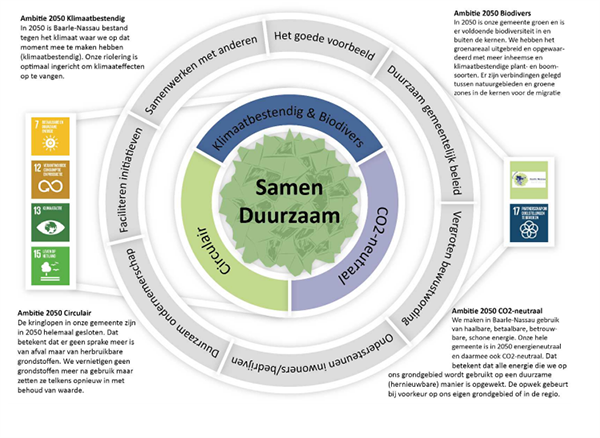BAARLE IS BUSY MOVING BOUNDARIES! - BAARLE-NASSAU
In 2019, the municipality of Baarle-Nassau drew up a sustainability vision in which the connection was explicitly made with a number of Global Goals.

Baarle-Nassau is a unique municipality due to the fact that within the municipality there are 22 enclaves that are Belgian territory. In addition, Baarle-Nassau has only 1 Dutch neighbouring municipality, but 5 Belgian neighbouring municipalities. With all these municipalities and the enclaves, the sustainability challenge is greater than ever. Because how do we explain to residents that we must become natural gas-free in the Netherlands, while the residents of Belgium are getting natural gas? Another example is waste: this is continuously transported across national borders by the enclaves. To organise this, the municipality is working closely with Baarle-Hertog on a joint recycling centre and options are being explored for the collective collection of waste. In addition, climate adaptive measures are being taken in collaboration with Baarle-Hertog for the renewal and construction of sewage systems. The municipality also looks to its own organisation: for example, the municipality has a sustainable town hall with a thermal storage installation and the community school and MFA in Ulicoten have also been built sustainably. Information evenings on becoming natural gas-free were held for each centre in 2019. A total of 100 residents were present. These evenings were the start of the heat transition vision.
| "Attention to sustainability does not stop at the border. Our unique location requires us to work across borders with the Global Goals. This is a bridge to an international testing ground that the entire border region can benefit from." |
Baarle-Nassau is committed to reinforcing international administrative strength. Due to the unique situation, Dutch-Belgian issues associated with sustainability can be linked to daily practice. The municipality's ambition is to jointly gain more insight into this, devise solutions, test them and introduce new international working models. Because if it succeeds here, it will also help elsewhere along the border to facilitate cross-border cooperation in the field of sustainability. In doing so, the municipality wants to collaborate with partners in the Netherlands and Belgium, inside and outside the municipality, and knowledge, insights, test setups and working models can be shared with everyone. We want to offer added value for both municipalities, the Netherlands, Belgium, the Benelux and Europe. If we achieve results, then that is good for our residents and could perhaps be an example to apply elsewhere in Europe.
- Background information about our enclave situation can be found on the website of tourism Baarle: https://toerismebaarle.com/over-baarle/unieke-enclavesituatie/
- Here is more information about our administrative and official cooperation: https://www.baarle-nassau.nl/baarle-hertog.html

